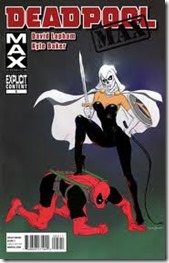DEADPOOL MAX #1-12 (Marvel, December 2010 – November 2011) David Lapham, writer. Kyle Baker, art. VC’s Clayton Cowles, letterer. Explicit Content.
Deadpo  ol remains enormously popular, as evidenced by the plethora of Marvel titles in which he appears. Some of the more discerning readers have had our fill of the wacky mercenary with ninja skills and powers that make him incredibly difficult to kill, while other readers just can’t get enough. Many of us recall fondly the early days of the title and some classic tales from Kelly, Priest, and Palmiotti. Flash forward to 2010 and the Marvel Max line of books: When a writer as skilled as David Lapham gets his hands on the character and gets the freedom to explore controversial subjects then we all need to pay attention. DEADPOOL MAX is a juicy slice of dementia with a generous sprinkling of laughs laced through its fatty veins.
ol remains enormously popular, as evidenced by the plethora of Marvel titles in which he appears. Some of the more discerning readers have had our fill of the wacky mercenary with ninja skills and powers that make him incredibly difficult to kill, while other readers just can’t get enough. Many of us recall fondly the early days of the title and some classic tales from Kelly, Priest, and Palmiotti. Flash forward to 2010 and the Marvel Max line of books: When a writer as skilled as David Lapham gets his hands on the character and gets the freedom to explore controversial subjects then we all need to pay attention. DEADPOOL MAX is a juicy slice of dementia with a generous sprinkling of laughs laced through its fatty veins.
In this version of the universe, The Deadpool is a secret C.I.A. side project to train and utilize mercenaries with no morals for assignments where killing and brutality may be essential. Their top agent is Wade Wilson, Deadpool. Action Officer Bob (a great creation) has been assigned to be Deadpool’s handler. Deadpool lives in a fantasy world and Bob’s mission is to keep him focused on their assignments. Bob quickly learns that Deadpool will quickly become coherent and efficient if he believes that the current mission is somehow connected to the Hydra organization, who he hates with a passion. Why Deadpool never turns on Bob, who wears a Hydra uniform without headgear throughout the issues, is a big mystery that doesn’t get attention until the final issue.
Most of the issues can be read as stand-alone stories, although there is a plot thread that is woven through all of the issues that involves Cable, Domino, and a female Taskmaster. Writer David Lapham puts his own spin on these Marvel characters and essentially mocks them in a funny way as he puts them through the paces. Artist Kyle Baker is in fine form, utilizing a variation on his standard style here that retains a Mad-magazine type of physical depiction and adds a coloring style that almost looks painted. Perhaps it’s the muted inks that make it appear that way. The only exception is Issue #9, which was drawn by Shawn Crystal in a style that is somewhat respectful of what Baker was trying to do but with a little more line definition. 
Issue #1 is a proper introduction to what’s in store, as Deadpool and Bob take out the Maggia boss Hammerhead (who Deadpool is led to believe is the new leader of Hydra) complete with extremely foul language, blood and gore, severed limbs and sick one-liners. It would be a horror book if not for Baker’s light-hearted depiction of massacre. Along with the blood, there is plenty of sex and drunken debauchery throughout this series, including two love affairs for Deadpool. Although, they may be the same woman. Is the mental patient Inez really someone else, or is this how Deadpool puts an irrational spin on everything he encounters? The KKK, Nazis, and bigots everywhere get the satiric treatment in Issue #3. The delightfully demented Lapham envisions a resurrected Baron Zemo as a cone-headed white supremacist leader of a new branch of the Klu Klux Klan.
In what I consider the core of this series (Issues #4 through #8), Cable and Domino enter the fray, along with the Taskmaster/Taskmistress. Both Bob and Deadpool get some intimate time with Domino, as they both have previous romantic ties to her. Deadpool has a history with Taskmistress also, during his formative years as a young Camper Cub (a sly version of the Boy Scouts) when she had more influence on his development than his own mother. Lapham morphs Marvel’s Moon Knight into an organization called the Crescent Moon Knights, a side branch of Eastern terrorists. Deadpool spends a few issues drifting in and out of a fantasy world where he’s a father (Domino’s child) raising a young costumed Deadpool. There’s a reoccurring plot thread where Deadpool and Bob are trying to stop the spread of a face-eating nerve gas called Liquid X.

Issues #9 through 11 are funny and demented, although they seem to drag in places. Issue #12 is a great wrap-up to the series (which was followed by DEADPOOL MAX II #1 the following month). The cover is a perfect depiction of the heart and tone of the entire series, as Deadpool and Bob toast each other with champagne glasses as a mushroom cloud erupts in the background. This is a series worth seeking out, provided you don’t object to having familiar Marvel characters and settings mashed up in a blender of parody.






